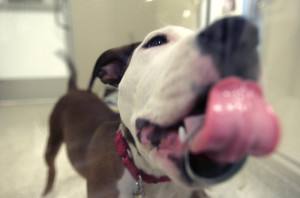August 16, 2012Comments are closed.dogs, WA Dog Laws

Western Australian pet owners are under yet another onslaught of ignorant and inhumane legislation courtesy of Local Government Minister John Castrilli. Not content to condemn hundreds of thousands of cats to a swift death in the local council pound, he has now set his sights on impounding hundreds of thousands of innocent pet dogs.
Since 2002 there have been laws which require ‘pit bulls’ to wear a prescribed collar, for the owner to display ‘dangerous dog’ signs, confine the dog in an escape proof enclosure, for the dog to leash and muzzled at all times in public and for the dog to be desexed.
These laws apply to the “American pit bull terrier”, “pit bull terrier” and “includes any dog of a mixed breed which visibly contains” any of these breeds. Identification is still proving a problem – as it was when Castrilli floated the idea of strengthening these laws back in 2009;
WA Rangers’ Association president Samantha Tarling said identification had emerged as a fundamental problem, with WA’s chief veterinarian refusing to “testify to the DNA” of a dog.
“I once challenged some owners that their dog was a pit bull,” she said. “They showed me the parents with the paperwork. It was a cross between a boxer and a labrador. I could have sworn it was a pit bull.”
She said some pit bulls looked like bull mastiffs, a breed that is not restricted.
Association president Samantha Tarling said the close genetic make-up of dog breeds made it impossible to prove a dog was a pit bull terrier, even with DNA testing, and owners were getting around the laws by claiming their pets were a different breed.
“People are registering pit bulls as a boxer cross, which is legal,” Ms Tarling said. “Not even the chief vet at the Agriculture Department will stand up in court and say ‘This is a pit bull’.”
Ms Tarling said rangers wanted the existing legislation dumped and replaced with an amended law to target individual animals instead of breeds.
She said singling out breeds wrongly assumed all those dogs were aggressive and that others were not dangerous.
“We would prefer to see the dangerous breed restriction taken away and the Act amended so that any aggressive dog can be declared dangerous,” she said.
“The existing laws are penalising everyone who owns a restricted breed, even if their dog is docile, and are not targeting some dangerous dogs that the restrictions do not apply to.” (ref)
However, ignoring the advice of experts Castrilli has forged ahead. The amendments to the act in Parliament last night puts ‘declared’ dogs (a dog who has been declared for chasing, menacing or attacking), and ‘restricted’ breeds into one category – ‘Dangerous Dogs’.
Whether a dog is friendly, healthy and happy – or has proven itself a danger to the community – makes no difference at all under Castrilli’s dog kill bill. They are all grouped together.
And how does the new bill identify restricted breeds exactly?
A dangerous dog (restricted breed) means a dog that —
(a) is of a breed prescribed by the regulations to be a restricted breed; or
(b) is a mix of 2 or more breeds, one being a breed prescribed by the regulations to be a restricted breed;
And that’s it. There’s no identification plan outside of the ranger’s association identification outline, which looks like this:
The QLD government worked from a deeply flawed ’22 point checklist’ to identify ‘pit bulls’ only to have it quickly discredited in court. The Victoria’s issued the ‘pit bull manifesto’ and is currently seeing it challenged and overturned constantly when owners fight back. But WA dogs don’t get more than a he-said-she-said ranger or vet appraisal before being condemned.
In any proceedings taken against a dog owner, the onus of proving their particular dog is not a dangerous (restricted breed) lies on the owner. You will have to be able to prove your dog is NOT a pit bull or pit bull cross.
Once a dog has been declared a dangerous (restricted breed) the dog cannot be advertised, sold or transferred (including by rescue groups). The dog must be kept in an enclosure which not only prevent the dogs from escaping, but also prevent a child from inserting any part of its body into the enclosure (which implies solid walls). Council can also refuse to register it.
The fines for breaches of the Dog Act for dangerous (restricted breed) dog owners range up to $20,000.
The RSPCA has come out against the new bill;
RSPCA WA spokesman Tim Mayne told AAP his organisation welcomed compulsory microchipping, but breed-specific laws were the wrong approach.
“It’s the deed, not the breed,” he said.
“It’s all about how an animal is socialised or trained.
“We would prefer to see all dog owners have training.”
Mr Mayne said a recent attack on a five-year-old girl in WA involved “five or six different breeds, none of which were on the banned breed list”.
There is no evidence that restricting particular breeds helps reduce dog attacks. Breed specific legislative measures reflect a simplistic and unrealistic appreciation of the factors which lead to dog bites. Stereotyping and misinformation in support of breed specific solutions, no matter how politically popular, does not make our community safer. Continuing to focus on breed is simply bad policy.